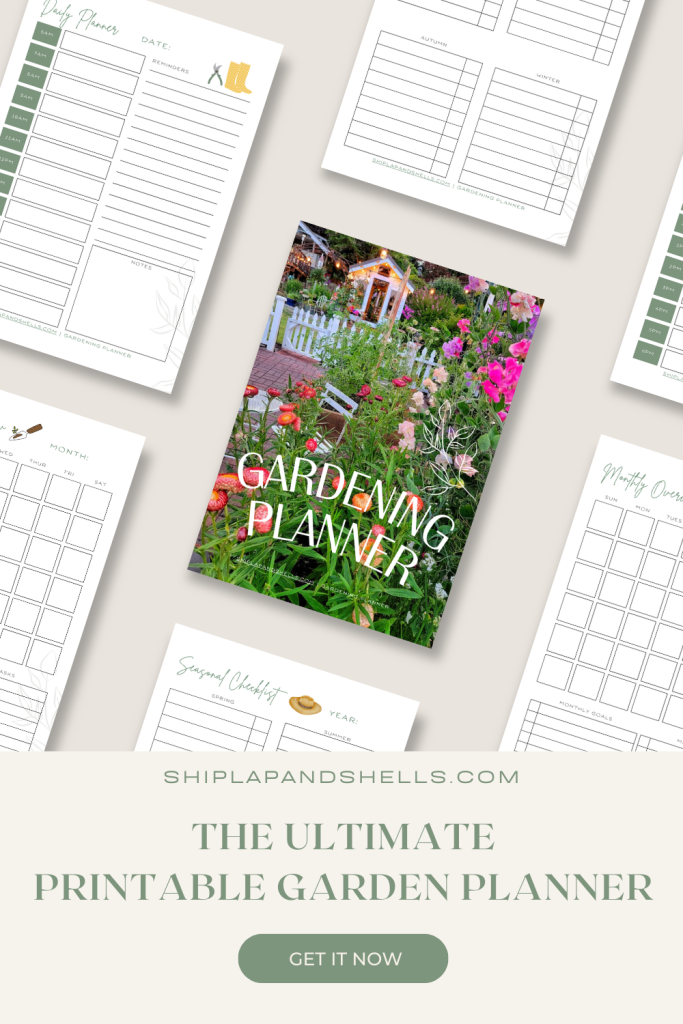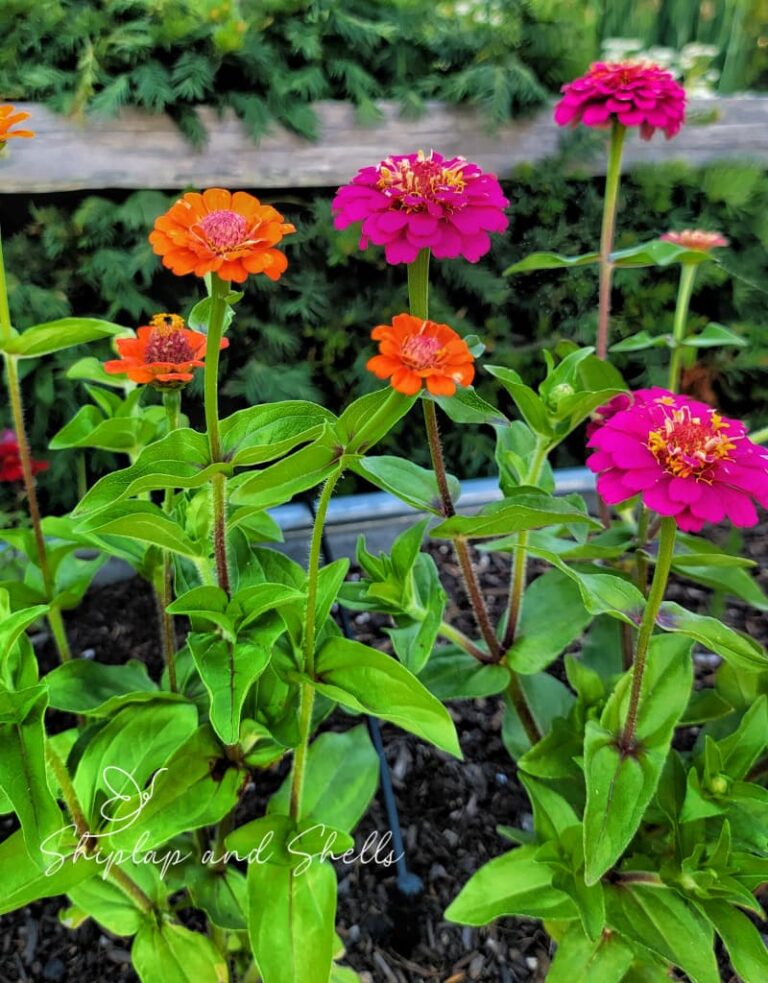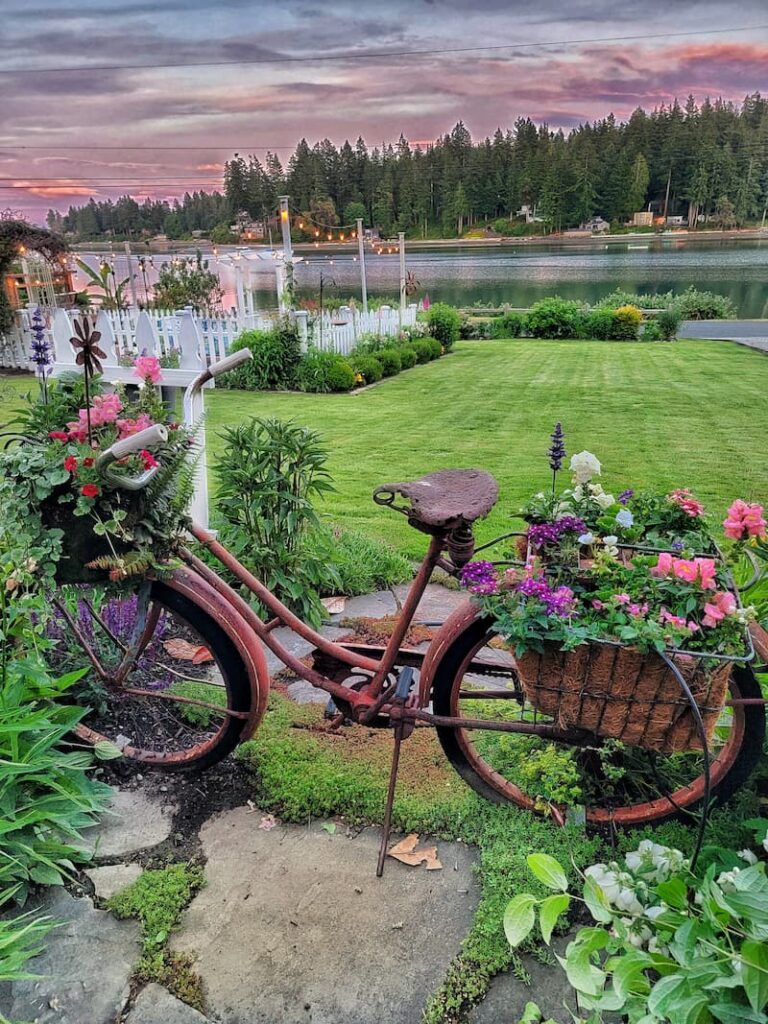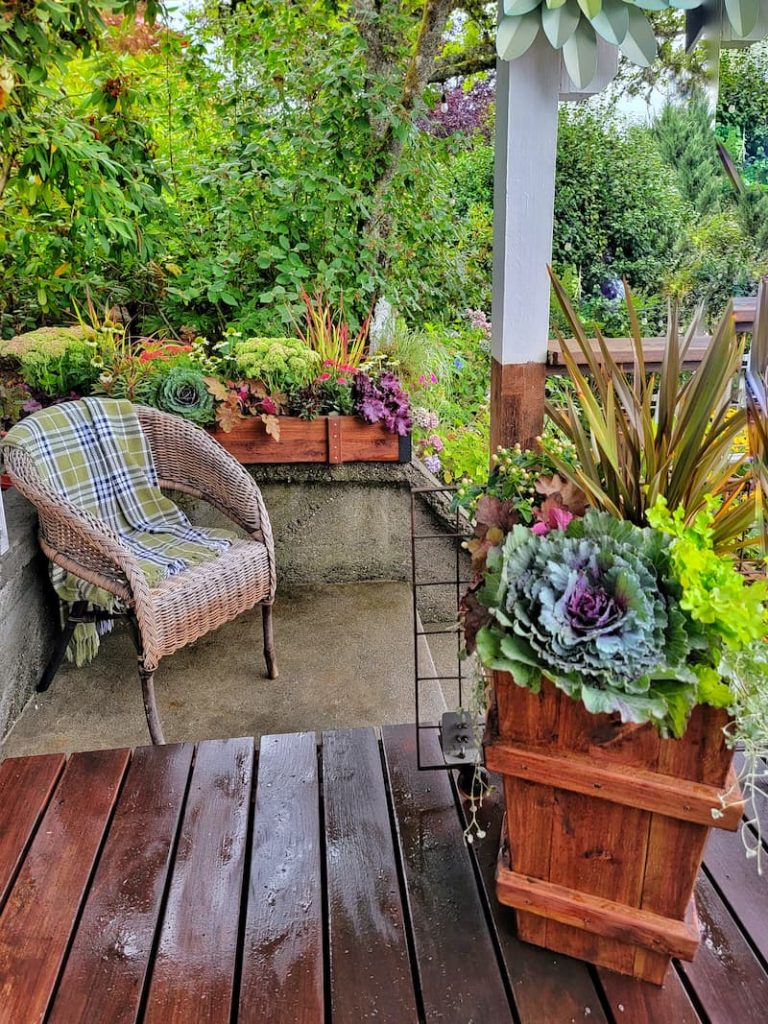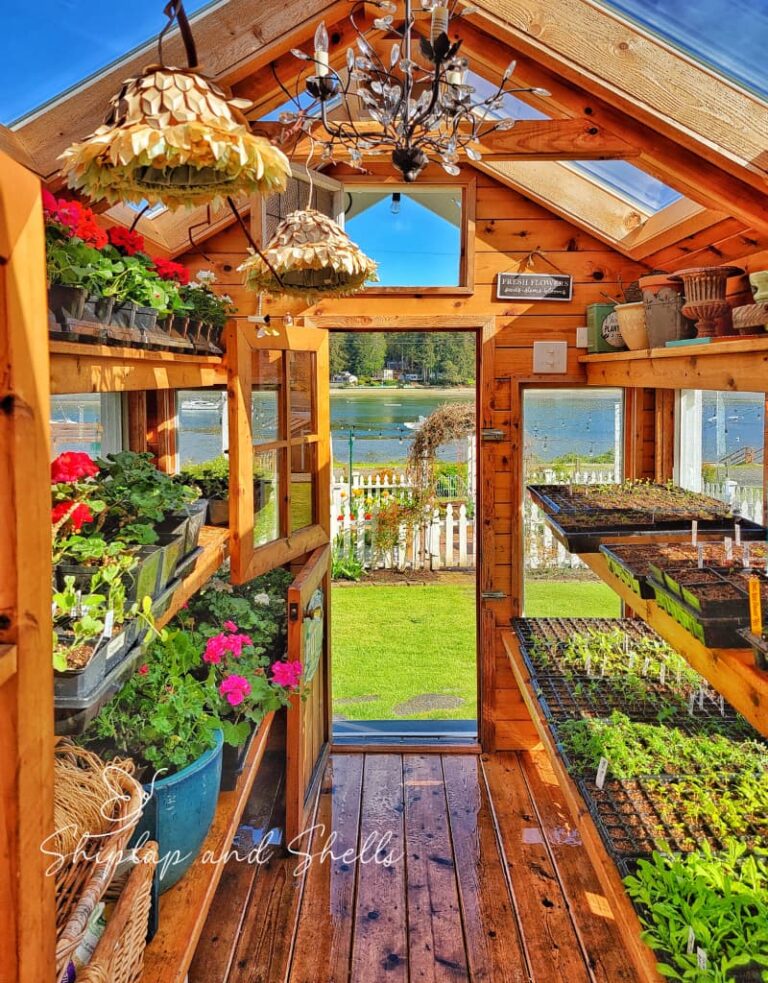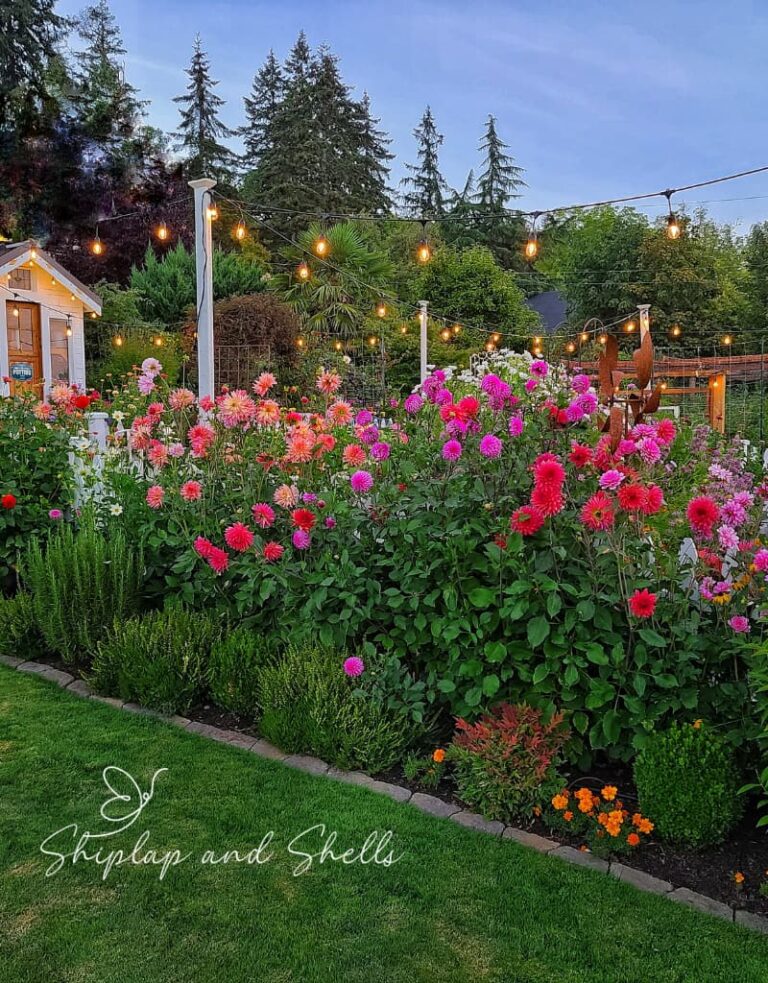Growing Sunflowers from Seed: A Complete Guide
Thinking about growing sunflowers from seed in your garden this summer? This easy-to-follow guide will walk you through everything you need to know, from picking the right kinds of sunflowers to planting, caring for them, and even harvesting.
There’s just something about sunflowers that feels like pure summer. Their tall stems and bright, happy faces add a cheerful touch wherever they grow.
Whether you want a whole patch of sunflowers for bouquets or just love the look of them mixed into your veggie or cottage garden, there are so many reasons to try them.
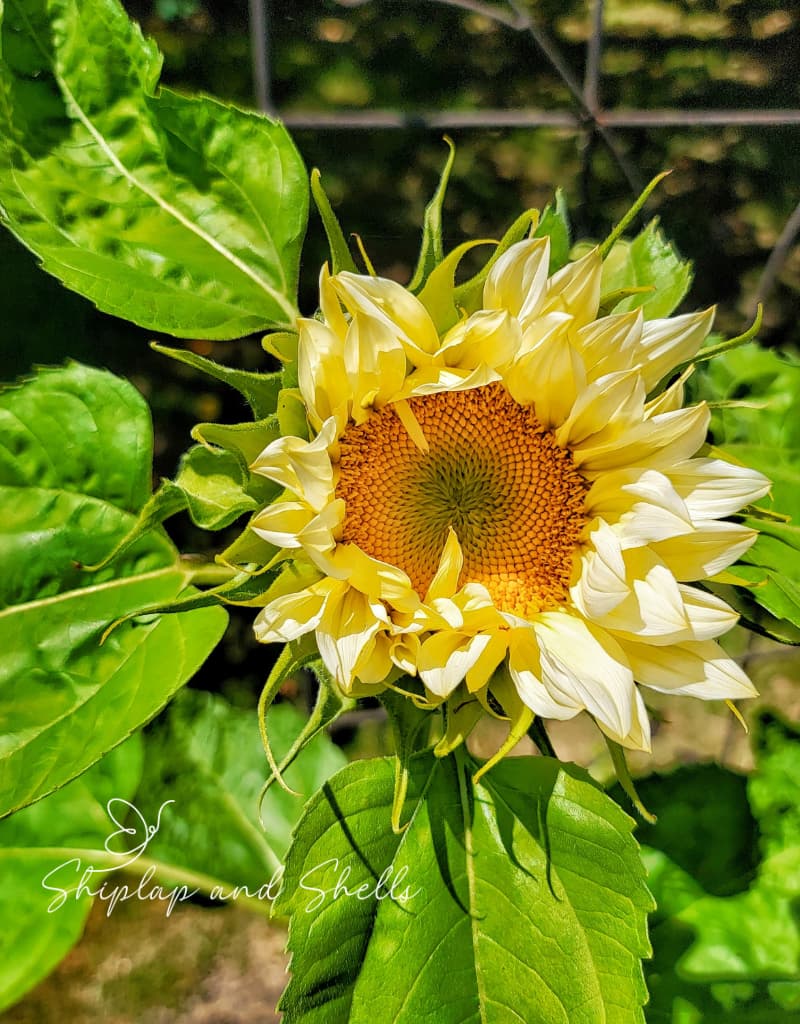
As an Amazon affiliate, I earn from qualifying purchases at no extra cost to you. My blog contains other affiliate links for your convenience as well. Click here to read my privacy policy.
About Sunflowers
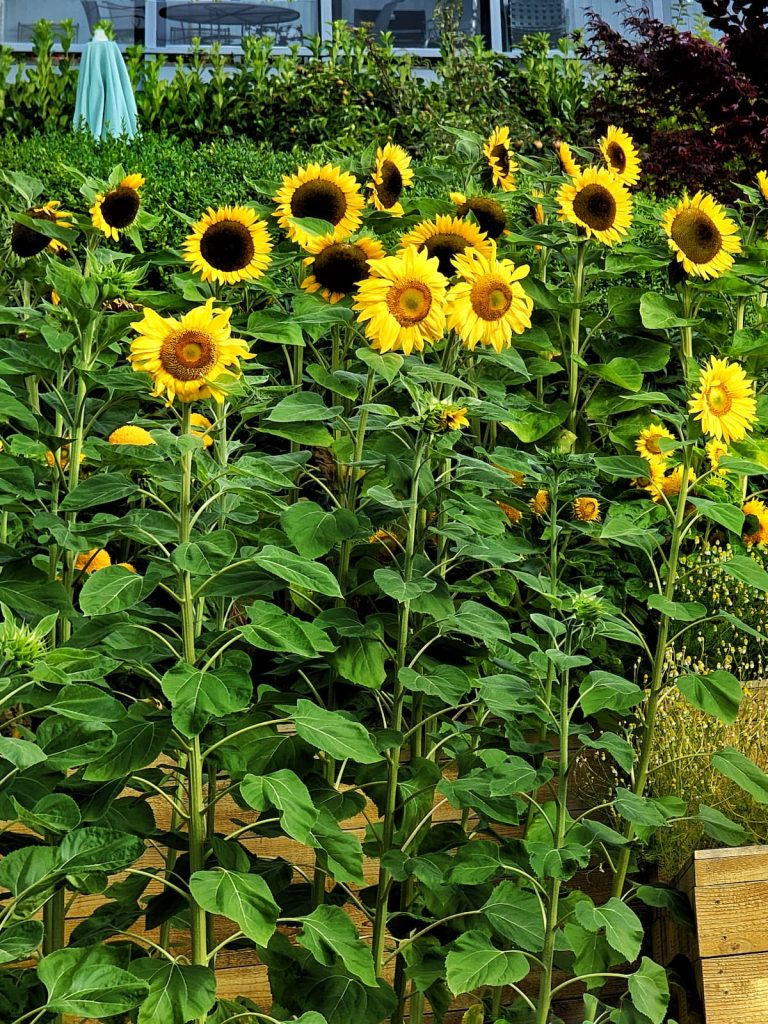
Sunflower plants (botanical name: Helianthus annuus) are stunning summer flowers with unmistakable golden blooms and towering stems.
Depending on the type you grow, some sunflowers have one big flower at the top, while others branch out with multiple blooms. The stems are usually a bit rough and can grow several feet tall, making them a bold and beautiful statement in any garden bed.
| USDA Hardiness Zones | 2-11 |
| Typical Bloom Time | mid-summer into early fall |
| When to Plant | after the last frost once the garden soil is at least 55°F. |
| Colors | Yellow, mahogany, red, bicolor |
Not sure if sunflowers will thrive where you live? It helps to know your USDA hardiness zone and your area’s average last frost date—that’ll give you a good idea of when to plant.
Keep reading for all the sunflower basics, including whether they come back each year, how long they bloom, how tall they can get, and the best varieties to grow from seed.
Are Sunflowers Annuals or Perennials?
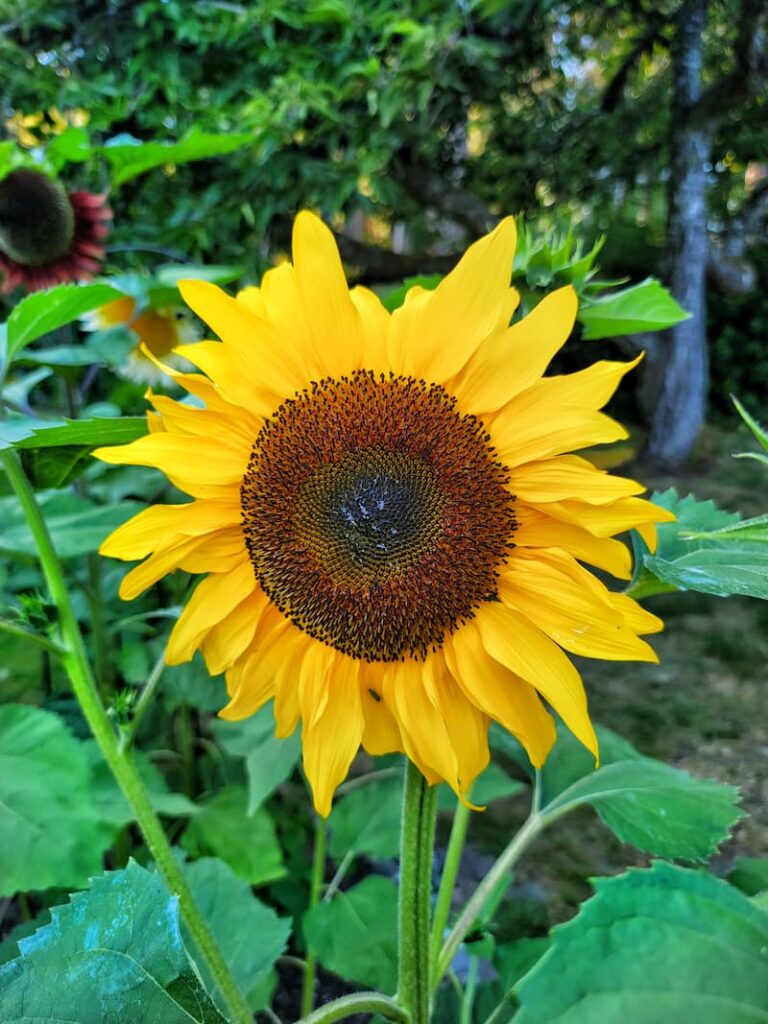
That depends on the variety. Most sunflowers you see in gardens are annuals, which means they grow from seed, bloom, and finish their life cycle all in one season. They’re easy to grow and give you big, bold flowers quickly.
But there are also perennial sunflowers, like Helianthus maximiliani and Helianthus multiflorus, that come back year after year if you care for them. They usually don’t grow as tall or have flower heads as big as the annual types, but they’re still beautiful and bring a lovely, long-lasting touch to your garden.
How Long Do Sunflowers Take to Bloom?
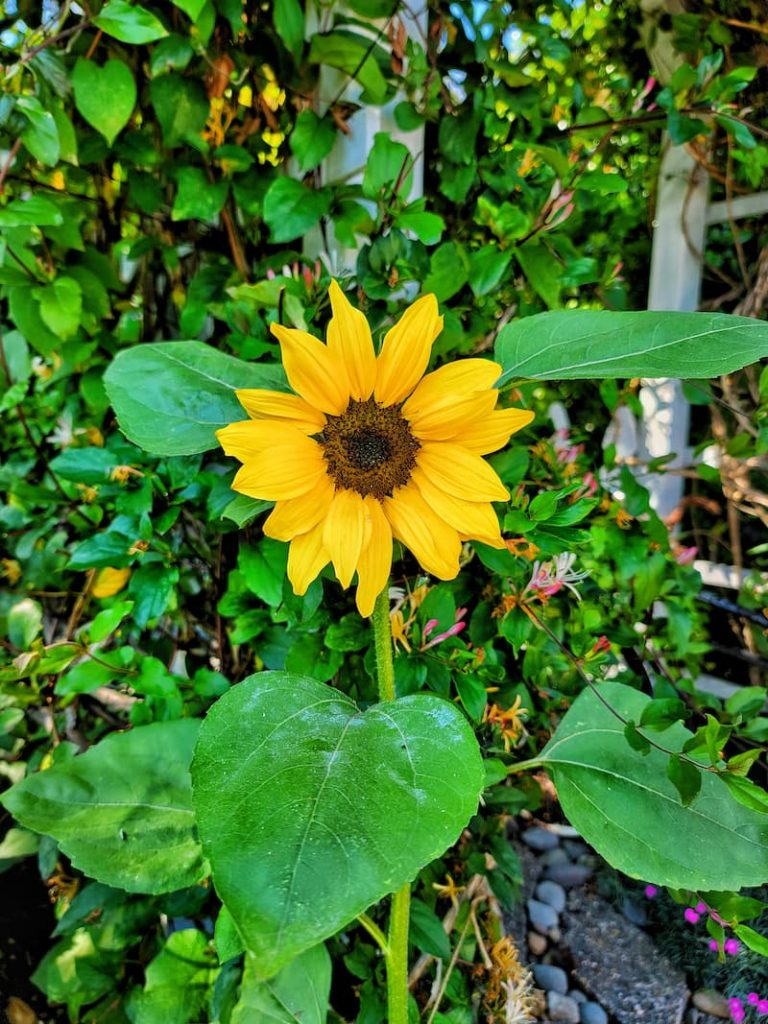
It really depends on the type of sunflower you’re growing and your local conditions, but most sunflowers bloom somewhere between 70 and 100 days after planting.
Some of the smaller, faster-growing varieties—like Teddy Bear or Sunspot—can start blooming in just 60 days. The bigger guys, like Mammoth, usually take a bit longer, closer to 90 to 100 days, since they grow so tall.
If you’re growing perennial sunflowers, they take a little more time to get going, especially in their first year. But once they’re established, you can expect them to bloom from late summer into early fall.
No matter the variety, giving your sunflowers lots of sunshine and regular water will help them bloom right on time and look their best.
Garden Supplies and Tools
Check out my favorite garden supplies and tools for the growing season. Whether you’re looking for potting soil or deer repellent, you’ll find what I use in my own garden.
How Tall Do They Get?
With the proper care and sunlight, sunflowers of all sizes can flourish beautifully in your garden.
Best Sunflower Varieties to Grow from Seed
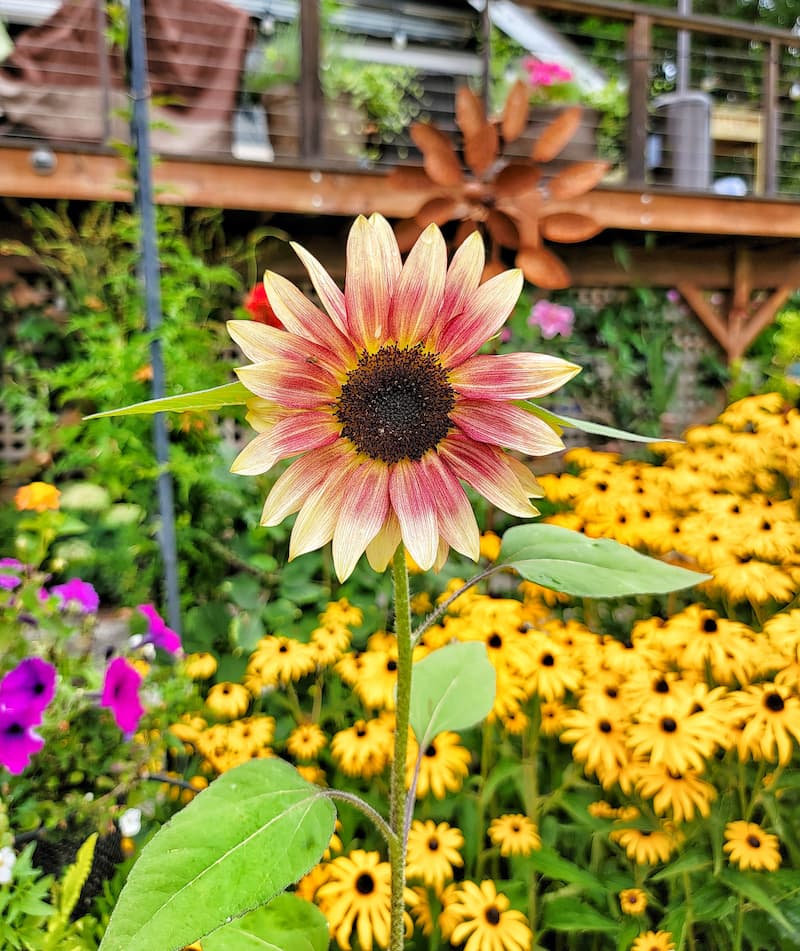
There are so many beautiful sunflower varieties to choose from—it really depends on what kind of look you’re going for and how much space you have.
If you want to grow something tall and impressive, Mammoth and Russian Giant are classic favorites. These towering sunflowers can grow up to 15 feet tall and have huge blooms that really make a statement.
Looking for rich colors and lots of blooms? Try Autumn Beauty for a mix of warm gold, bronze, and deep mahogany, or Velvet Queen with its stunning burgundy petals. These varieties are great if you love that wild, cottage-garden feel.
Short on space? No worries—there are some adorable dwarf varieties like Teddy Bear, Sunspot, and Little Becka that are perfect for small gardens or even pots and containers.
If you’d like your sunflowers to come back year after year, check out perennial types like Helianthus maximiliani or Lemon Queen (Helianthus multiflorus). They may not be as tall, but they’re just as lovely and great for long-term garden beauty.
Personally, I’m a big fan of Pro Cut White Lite and Red Pro Cut—they’re absolutely gorgeous and make amazing cut flowers!
How to Grow Sunflowers from Seed
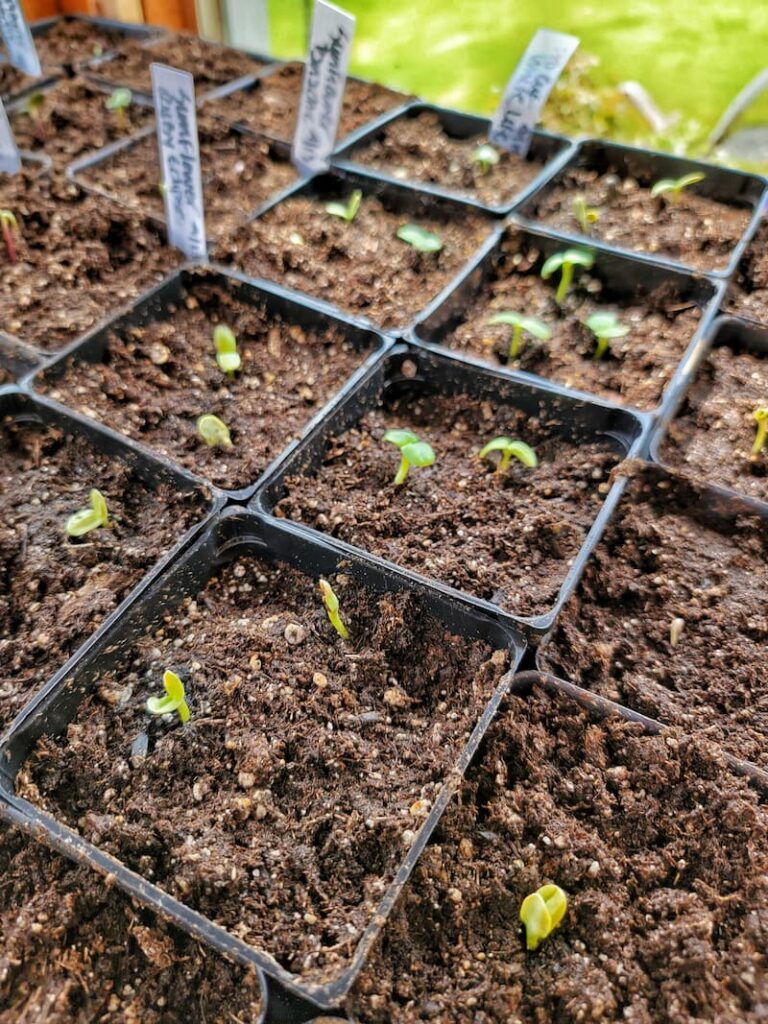
If you’re new to growing sunflowers, don’t worry. From planting to blooming, here are some easy steps and helpful tips to get your sunflowers off to a strong start so they’ll shine all summer long.
Germinating Sunflower Seeds Indoors
Getting a head start by starting seeds indoors is a great option, especially if you live in a cooler climate or want to avoid birds snacking on your freshly planted seeds (been there!). I like to sow mine in the greenhouse for just that reason.
To get started, fill small biodegradable pots with a good seed-starting mix. Plant your sunflower seeds about 1 inch deep, then gently cover with soil.
Bottom water gently to moisten the soil, then place the pots in a warm location with plenty of sunlight or under grow lights. Cover the pots with a clear plastic lid or plastic wrap to maintain consistent humidity and warmth. Within 7 to 10 days, you should see tiny green shoots emerging as the seeds germinate.
Water from the bottom to keep the soil evenly moist, and place the pots in a warm, sunny spot—or under grow lights if you have them. To keep humidity in, cover the pots with a clear plastic lid or even plastic wrap. Within 7 to 10 days, you’ll start to see little green sprouts peeking through!
Once your seedlings have their first true leaves and the outdoor soil has warmed up, it’s time to start hardening them off—slowly introducing them to outdoor conditions—before transplanting them into your garden. This early head start really helps them grow strong and healthy.
Prepping Sunflower Seeds for Planting
Before planting, a little seed prep can go a long way in helping your sunflowers grow their best.
Start by choosing good-quality seeds from a trusted supplier or ones you’ve saved from last season. Toss any that look damaged or discolored.
To test older seeds, soak them in a bowl of water for a few hours. Viable seeds will sink, and the floaters might not grow. Soaking seeds overnight also helps soften the seed coat and can speed up germination.
If you want to give them an extra boost, you can gently scarify them by rubbing the seed coat with sandpaper—just enough to thin the outer layer a bit.
Once your seeds are ready, you can either start them indoors like we talked about or plant them straight into the garden when the soil is warm and there’s no more risk of frost.
Best Soil for Growing Sunflowers from Seed
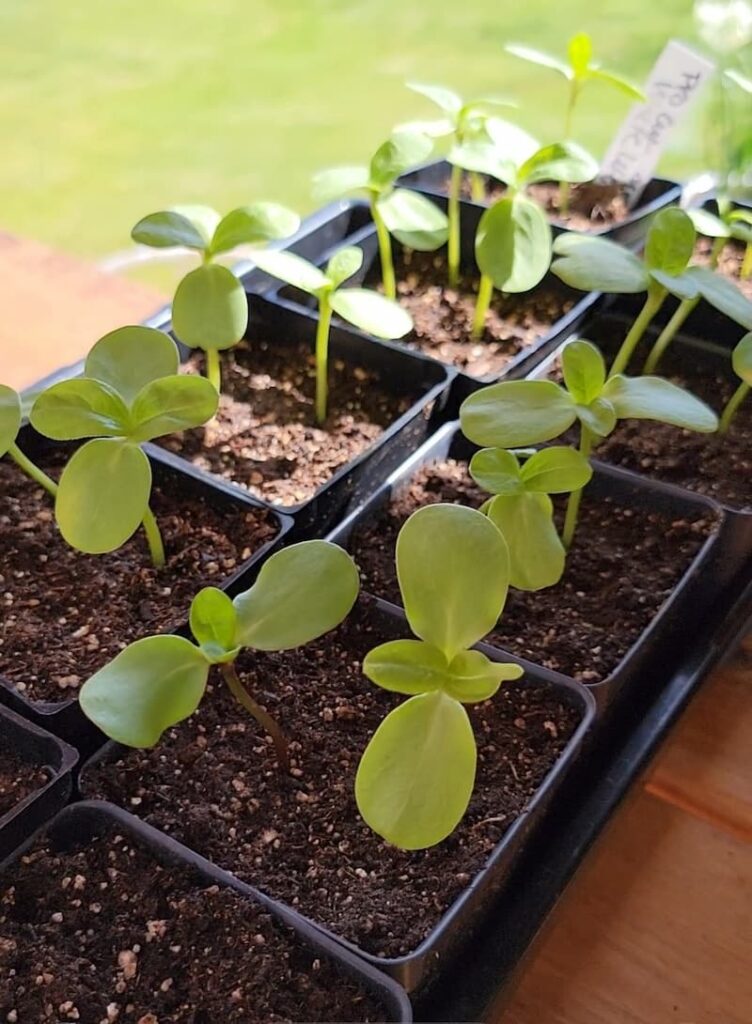
Sunflowers are pretty easygoing, but they’ll grow their best in the right kind of soil—so it’s worth taking a few minutes to check what you’re working with.
A simple soil test kit (or sending a sample to your local extension service) can help you determine your soil’s pH and nutrient levels. Just follow the instructions on the kit, or if you send it to a lab, they’ll send back a report with helpful information.
Once you know what your soil might be missing, you can mix in the right compost or fertilizer to give your sunflowers what they need.
Sunflowers love nutrient-rich, well-draining soil with a pH between 6.0 and 7.5. Before planting, loosen the soil down to about 12–15 inches—they grow deep roots and need that space to stretch out.
Adding compost or aged manure is a great way to improve fertility and help hold just the right amount of moisture.
Sandy loam is ideal for sunflowers. It drains well but still holds onto enough moisture to support strong, healthy growth. If your soil is super heavy (like clay) or too sandy, no worries—just mix in plenty of compost or other organic matter to help balance things out.
SHOP SOIL TEST KIT HERE.
What is the Best Fertilizer for Sunflowers?
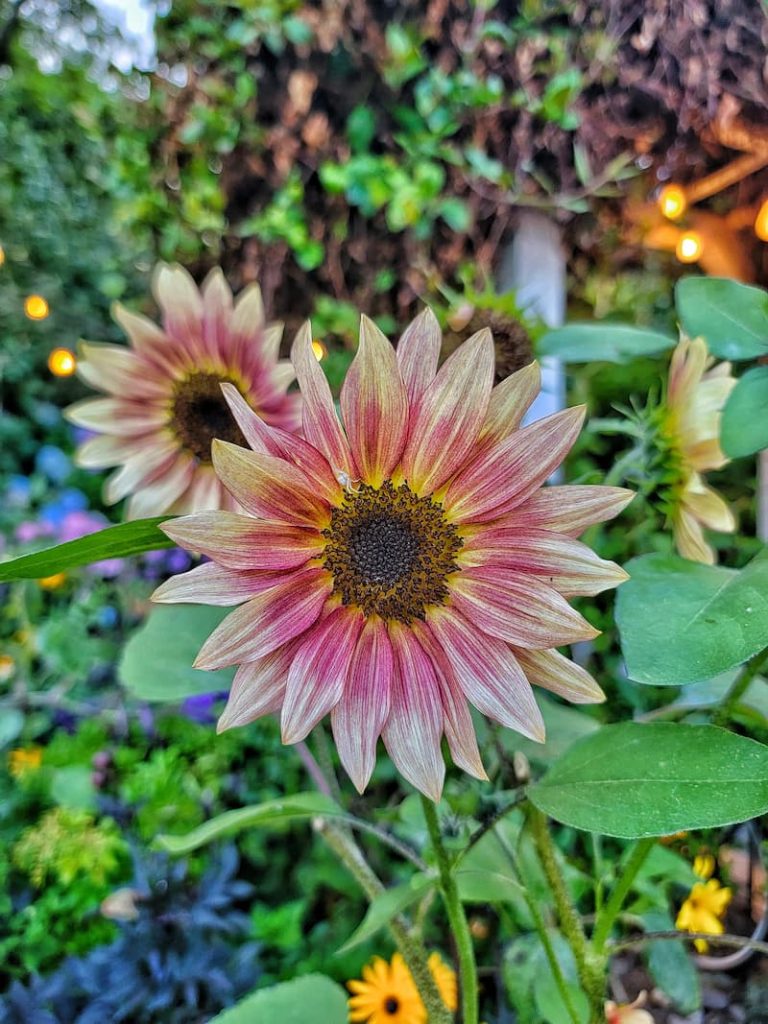
Sunflowers grow big, bold, and beautiful, but they need plenty of nutrients to do that. These plants are heavy feeders, so giving them a little boost along the way really helps.
The best fertilizer for sunflowers is a balanced blend. Look for something like a 10-10-10 or 5-5-5 formula, which gives equal parts nitrogen (N), phosphorus (P), and potassium (K).
When your seedlings are about 6 inches tall, sprinkle a slow-release granular fertilizer around the base of each plant (this is called “side-dressing”). Then give them another feeding just before they start to flower. If you prefer using liquid fertilizer, use a diluted mix every 2–4 weeks during the growing season.
A quick tip: try not to overdo it on the nitrogen—too much will give you big leafy plants, but not many flowers. You really want a good balance, especially with phosphorus and potassium, to help your sunflowers grow sturdy stems and those big, cheerful blooms.
Do Sunflowers Like Full Sun or Shade?
Sunflowers are true sun-lovers—they need at least 6 to 8 hours of direct sunlight every day to really thrive.
Full sun helps them grow strong, stand tall, and develop the biggest, brightest flower heads. They can get leggy and weak without enough light, and the blooms might turn out smaller.
So, when choosing a spot for planting, find the sunniest part of your garden. Your sunflowers will thank you with a show-stopping display!
Seed Starting Supplies
Check out my favorite supplies and tools for starting seeds indoors. Whether you’re looking for grow lights or a seed starting mix, you’ll find what I use in my own greenhouse.
Planting Sunflower Seeds Outdoors
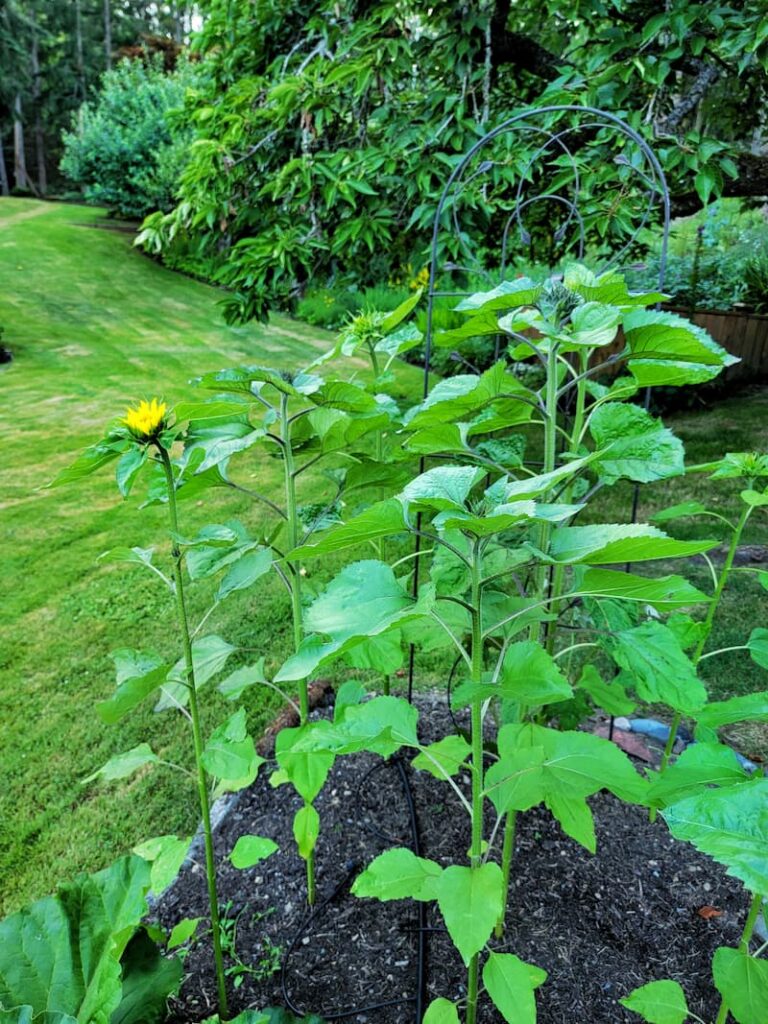
Sunflowers are tough, sun-loving flowers that grow best when planted directly into the ground. Starting them outdoors in well-prepped soil helps them grow strong roots from the beginning, which means healthier plants and bigger blooms!
In this section, we’ll cover the best time to plant, how to pick the perfect spot, and how to get your soil ready so your sunflower seeds can thrive.
When is the Best Time to Plant Sunflower Seeds?
The best time to plant sunflower seeds is after the last frost and once the soil has warmed up to around 50–60°F (10–15°C). For most places, that’s sometime in late spring, usually April or May.
Since sunflowers love the heat, planting them too early can slow things down. If you’re in a cooler climate or just eager to get started, you can start seeds indoors about 2–3 weeks before your last frost, then transplant them outside once the weather warms up.
Want blooms that last all summer? Try succession planting—just sow a few seeds every 2 to 3 weeks until mid-July, and you’ll have waves of sunflower blooms to enjoy through the season!
How to Plant Sunflowers
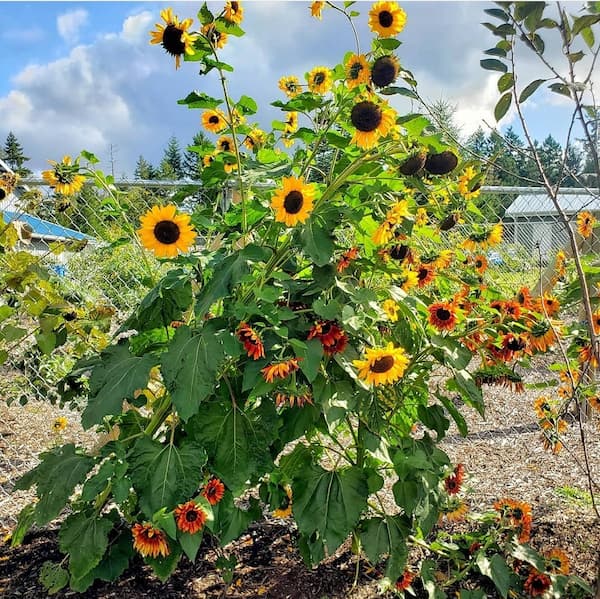
Planting sunflowers is simple, whether you’re starting seeds indoors or sowing them straight into the garden.
If you’re planting outdoors, pick a sunny spot with well-draining soil, and loosen the soil to about 12–15 inches deep. Sunflowers grow deep roots and love having room to stretch.
Plant your seeds about 1 inch deep. For smaller sunflower varieties, space them 6 inches apart. For the big ones, go for 10 to 12 inches apart. If you’re planting in rows, leave 2 to 3 feet between rows so the plants have plenty of space to grow.
Once the seeds are in the ground, cover them with soil and water gently. Keep the soil evenly moist (not soaked) while they’re getting established.
What Not to Plant With Sunflowers
As much as we love sunflowers, they don’t always play nice with certain plants. Sunflowers naturally release a compound (called allelopathy) from their roots, stems, and leaves that can slow down or even stop other plants from growing well nearby.
Avoid planting sunflowers too close to potatoes, pole beans, or bush beans—they’re especially sensitive to this effect.
Also, because sunflowers grow tall and cast a lot of shade, they can block sunlight from sun-loving plants like tomatoes and peppers. To avoid this, try planting your sunflowers on the north side of your garden so they don’t block the sun from your other crops.
Can You Grow Sunflowers in Containers?
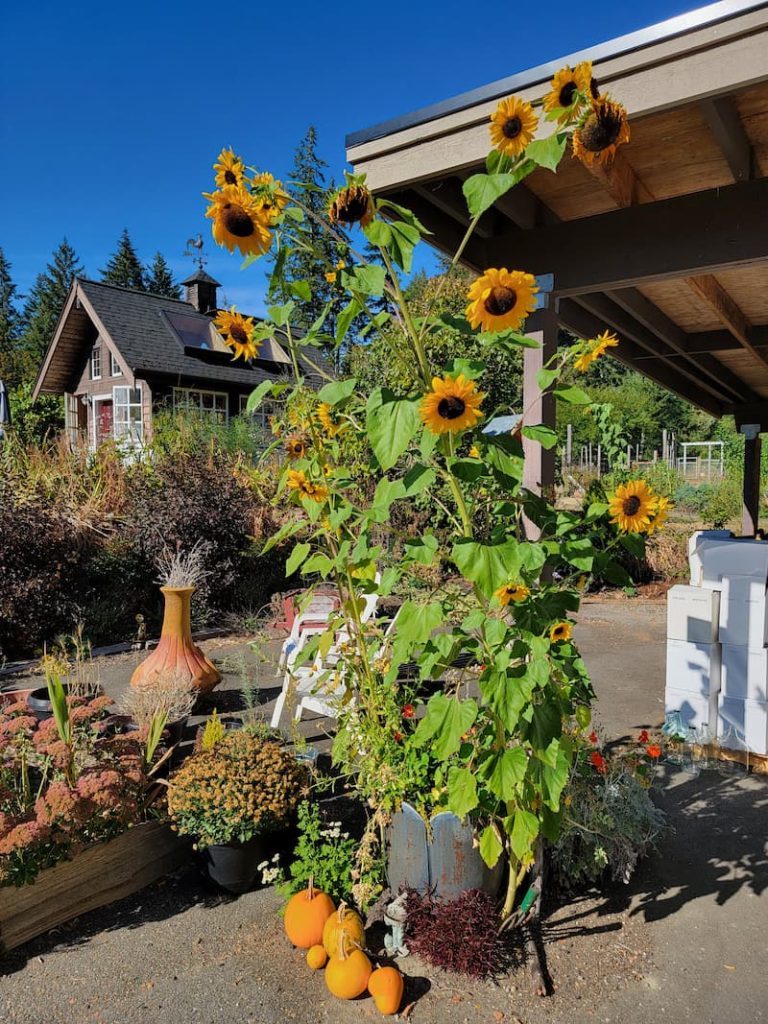
Absolutely! Growing sunflowers in containers is a fun and easy way to add some sunny charm to your patio, balcony, or small garden space. It’s a great option if you’re short on room but still want those cheerful blooms.
For container gardening, go with dwarf or medium-sized varieties like Teddy Bear, Sunspot, or Little Becka. These stay compact, usually around 2 to 4 feet tall, but still bring plenty of color and personality.
To give the roots enough space to grow, pick a container that’s 12–18 inches wide and at least 12 inches deep. Make sure it has drainage holes at the bottom, and fill it with a good-quality potting mix.
Plant your seeds about 1 inch deep, following the spacing recommendations for the variety you’re using. Then place your container somewhere sunny. Remember, sunflowers need at least 6 to 8 hours of direct sunlight a day to really thrive.
Keep the soil evenly moist, but not soggy, and you’ll have happy little sunflower plants in no time.
SHOP FOR HIGH-QUALITY POTTING MIX HERE
Sunflower Care Guide
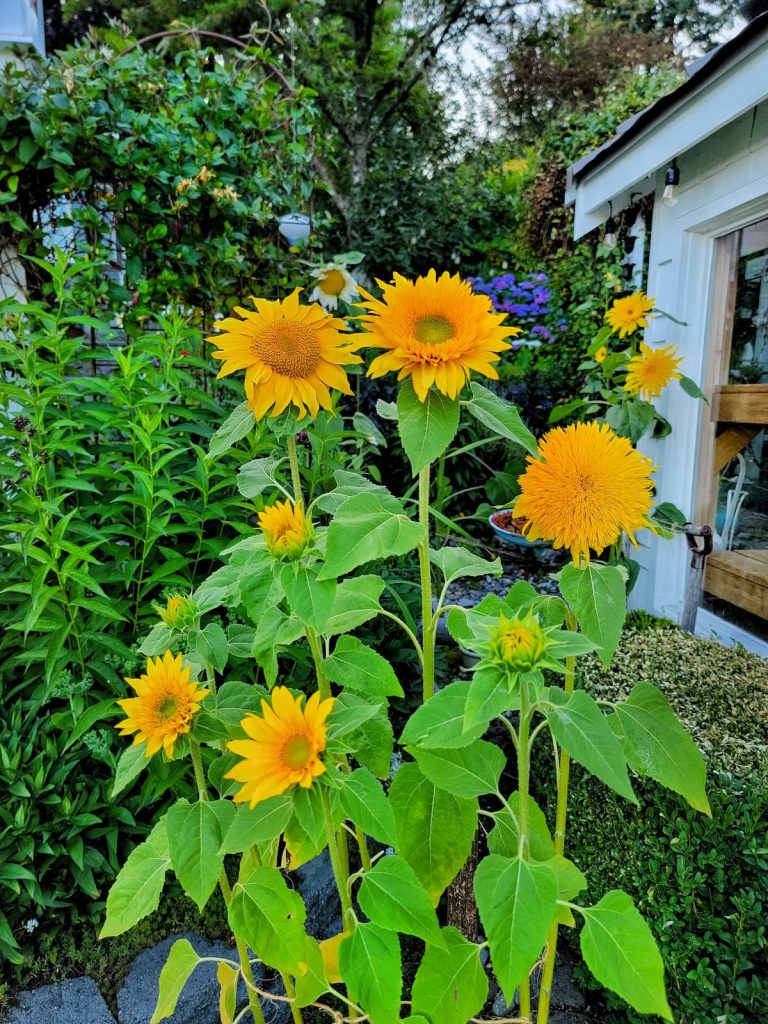
Once your sunflowers are up and blooming, it’s all about helping them stay healthy and happy through the rest of the season.
This part of the guide covers everything you need to know about watering, feeding, supporting, and keeping an eye out for pests so your sunflowers keep looking their best!
Watering Sunflowers
While sunflowers are pretty tough once they’re fully grown, they still need consistent watering, especially when they’re just getting started.
Keep the soil evenly moist when your seeds are sprouting and your seedlings are still small. This helps them build strong root systems early on.
Once your sunflowers are bigger, a deep watering about once a week usually does the trick, but that can vary depending on your weather and soil type. Aim for around 1 inch of water per week, and bump that up to 2 inches during especially hot or dry spells.
Water at the base of the plant (not on the leaves!) to help prevent any fungal issues. And don’t forget to add a layer of mulch around the base. This keeps the roots cool and helps the soil hold onto moisture longer.
Staking
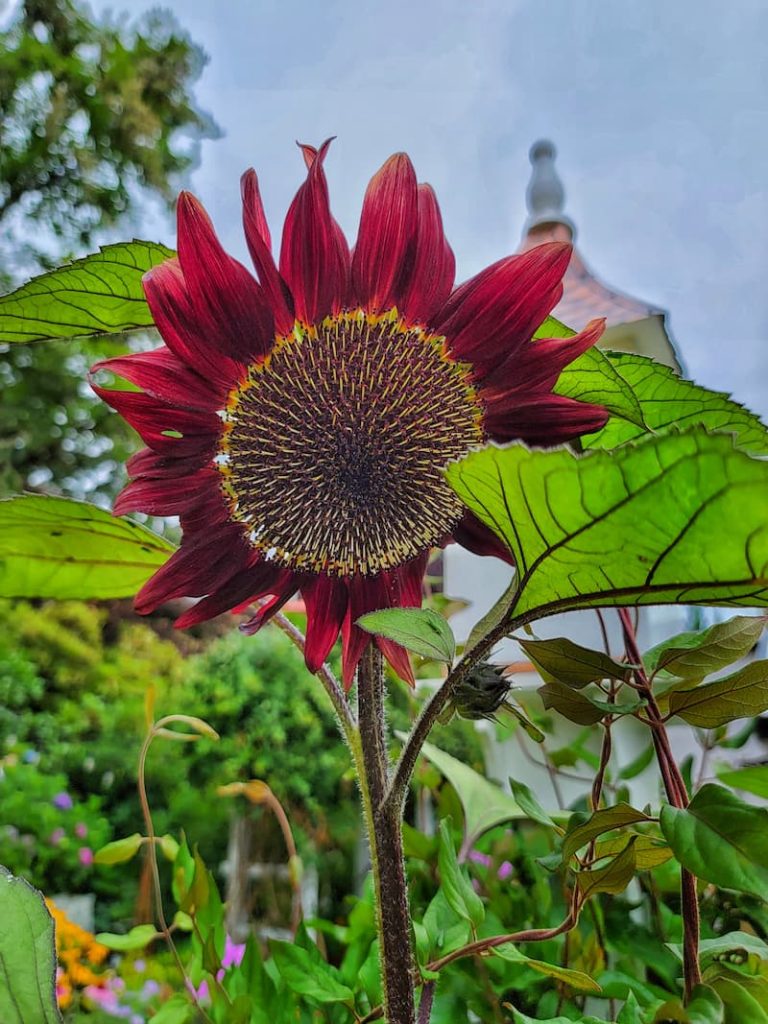
Some sunflower varieties get really tall, and a strong gust of wind or a heavy rainstorm can easily knock them over. That’s where staking comes in—it helps keep your sunflowers standing tall.
It’s best to start staking early, while the plants are still young and easy to work with. Use something sturdy like a bamboo stake, cane, or small trellis, making sure it’s at least 6 feet tall to support the plant’s full height.
Push the stake into the ground about 6 inches away from the base of the sunflower. As it grows, gently tie the stem to the stake using soft garden twine or plant ties. Secure the stem every 12 inches or so, and make sure your ties are loose enough to let the plant grow naturally.
If you’re growing a really large sunflower or one that branches out a lot, you might want to add multiple stakes or even create a little support frame around it for extra stability.
Deadheading
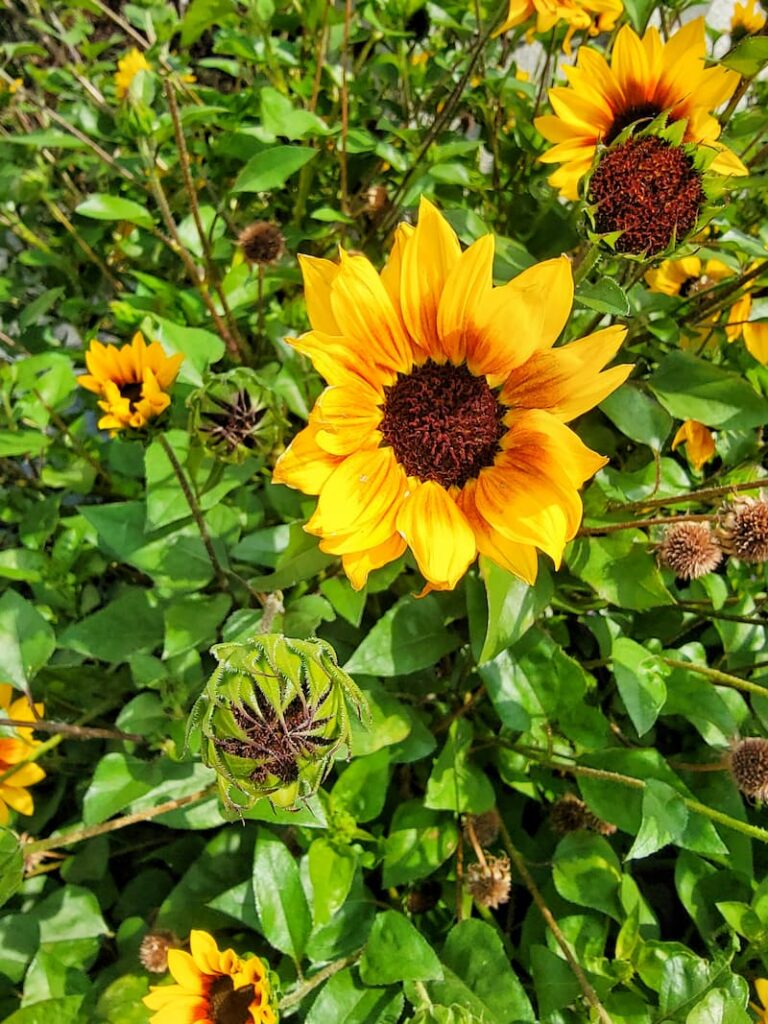
Deadheading, removing faded flowers, is a simple way to encourage more blooms (in some varieties) and keep your garden looking neat.
When a sunflower head starts to fade or lose its color, that’s your cue. Just grab a pair of clean, sharp garden shears and snip off the spent bloom just above the first set of healthy leaves or where the stem branches out.
For branching varieties like Autumn Beauty or Velvet Queen, deadheading helps the plant put its energy into growing new blooms instead of seed production.
If you’re growing a single-stem sunflower, like Mammoth, it won’t bloom again once the flower is done—but deadheading can still tidy things up and help prevent self-seeding where you might not want new plants popping up.
Once your sunflowers are finished blooming for the season, consider leaving the final flower heads on the plant. They’ll mature into seed heads, which are great for attracting birds or harvesting seeds to plant next year!
SHOP GARDEN SHEARS HERE
Common Pests
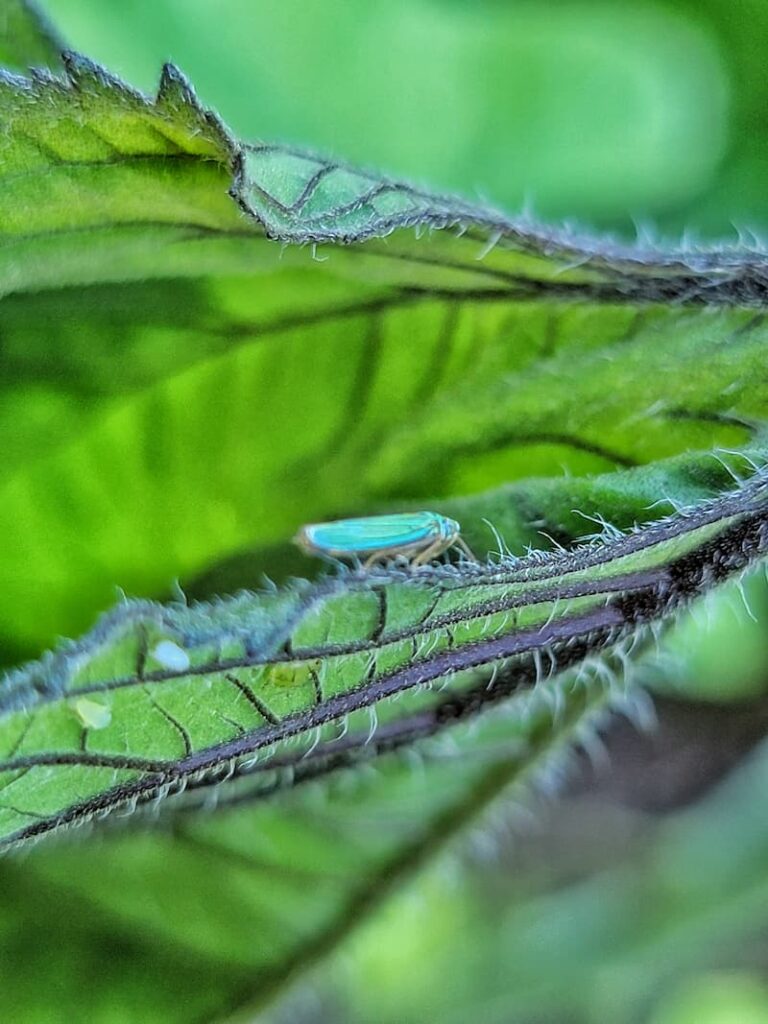
Sunflowers are pretty tough, but they can still run into a few pests and problems. Here are some of the most common ones to watch for and how to deal with them.
Aphids
These tiny pests love to hang out on stems and the undersides of leaves, where they suck the sap and cause wilting or curled leaves.
You can spray them off with a blast of water, treat the plant with insecticidal soap, or even better, invite ladybugs into your garden. They love snacking on aphids and make great natural pest control.
Beetles and Leafhoppers
Sunflower beetles and leafhoppers can chew little holes in the leaves and weaken the plant over time.
You can hand-pick beetles off if there aren’t too many, or use a gentle treatment like neem oil to help keep them at bay.
Birds and Squirrels
As your sunflower heads start to fill with seeds, birds and squirrels may see them as a tasty snack.
To protect your maturing blooms, cover the heads with mesh bags or garden netting. This will let the sun and air in but keep hungry critters out.
Common Sunflower Problems and Diseases
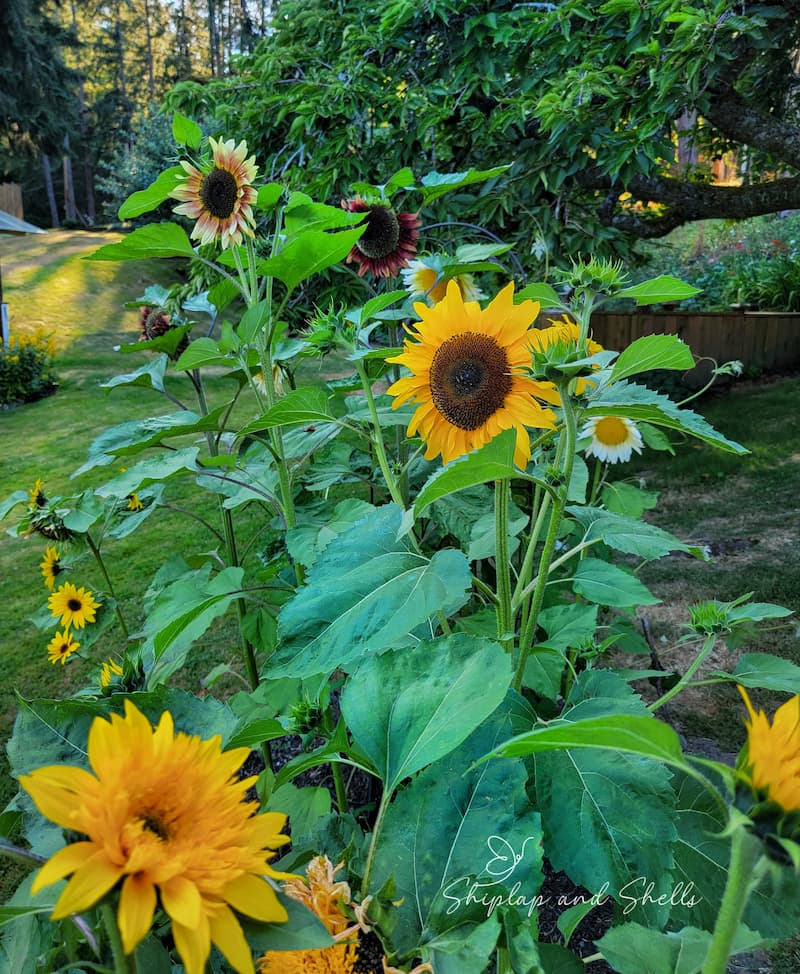
Even though sunflowers are pretty low-maintenance, they can run into a few issues now and then. Here are some common problems to look out for and how to fix them, so your sunflowers stay happy and healthy all season long.
Leggy Growth
If your sunflower plants are tall and spindly with weak stems, they might not be getting enough sunlight, or they could be too crowded.
Make sure they’re getting at least 6–8 hours of direct sunlight each day and give them plenty of space to grow. Good spacing helps the plants grow strong and upright.
Fungal Diseases
Fungal problems like powdery mildew, rust, and downy mildew can cause yellowing, wilting, or spotting on leaves.
To help prevent these issues:
- Space plants well to allow good airflow.
- Avoid watering from above—water at the base instead.
- Treat early signs of powdery mildew with neem oil or another gentle fungicide.
Root Rot
If your soil doesn’t drain well, your sunflowers could develop root rot or verticillium wilt, which can seriously stunt growth or kill the plant.
To prevent this:
- Always plant sunflowers in well-draining soil.
- Try to rotate where you grow them each year to reduce the risk of soil-borne diseases.
Nutrient Deficiencies
Yellowing leaves or slow growth can be a sign your plants need a little boost. Use a balanced fertilizer or add compost to replenish key nutrients and support strong, healthy growth.
Sunflower Head Droop
Sunflower heads naturally droop as they mature and fill with seeds—but if they’re drooping too early or the stems seem weak, it might be due to overwatering, a nutrient imbalance, or even heavy rain.
If needed, stake your plants to support the weight of the heads and keep them upright.
How Do You Keep Sunflowers Blooming All Summer?
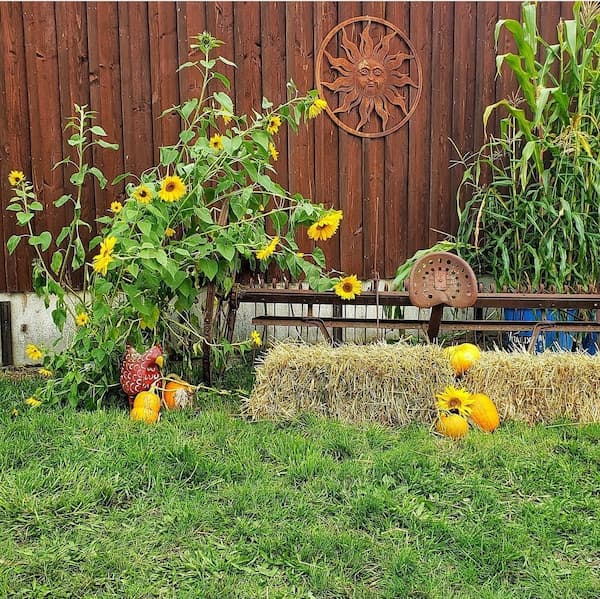
A few key gardening techniques are essential to keep sunflowers blooming all summer.
Month-By-Month Sunflower Grow Chart
Month 1: Sowing and Germination (April/May)
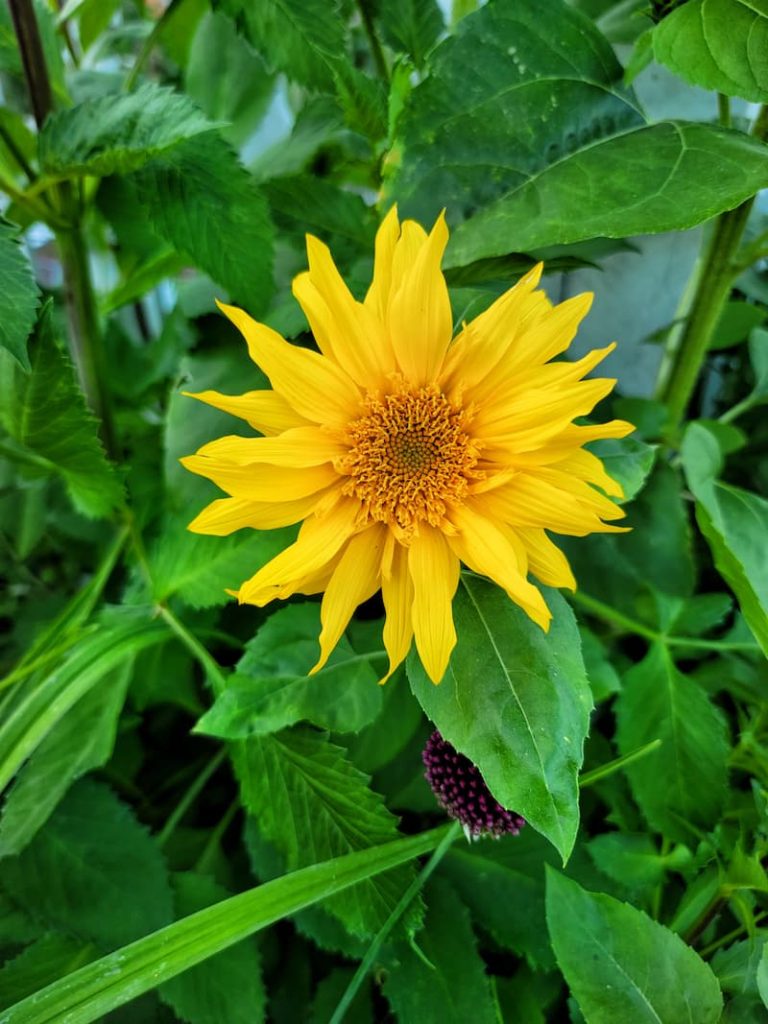
Start seeds indoors 4-6 weeks before the last frost date, or sow directly outdoors after the danger of frost has passed. The soil temperature should be around 50-60°F (10-15°C).
TASKS
Month 2: Seedling Stage (May/June)
Transplant seedlings outdoors after the last frost or thin direct-sown seedlings 1-2 feet apart.
TASKS
Month 3: Vegetative Growth (June/July)
Sunflowers will be rapidly growing in height.
TASKS
Month 4: Bud Formation (July/August)
Flower buds will start to form at the top of the stems.
TASKS
Month 5: Blooming Phase (August/September)
The flowers will open their beautiful blooms.
TASKS
Month 6: Seed Maturation (September/October)
Sunflower heads will begin to dry as seeds mature.
Sunflowers reach full maturity in around three months, after which they’re ready to harvest. Their colors start to brown, and the seeds grow heavy and thick and feel loose.
When the plant begins to wane and die, the flower head will also point towards the ground. At this point, cut off the flower heads (roughly one foot below the petals) and hang them in a cool, dry area for a week.
TASKS
Month 7: Harvest and Cleanup (October/November)
Harvest remaining seeds and clean up the garden.
TASKS
Harvesting Sunflowers and Sunflower Seeds
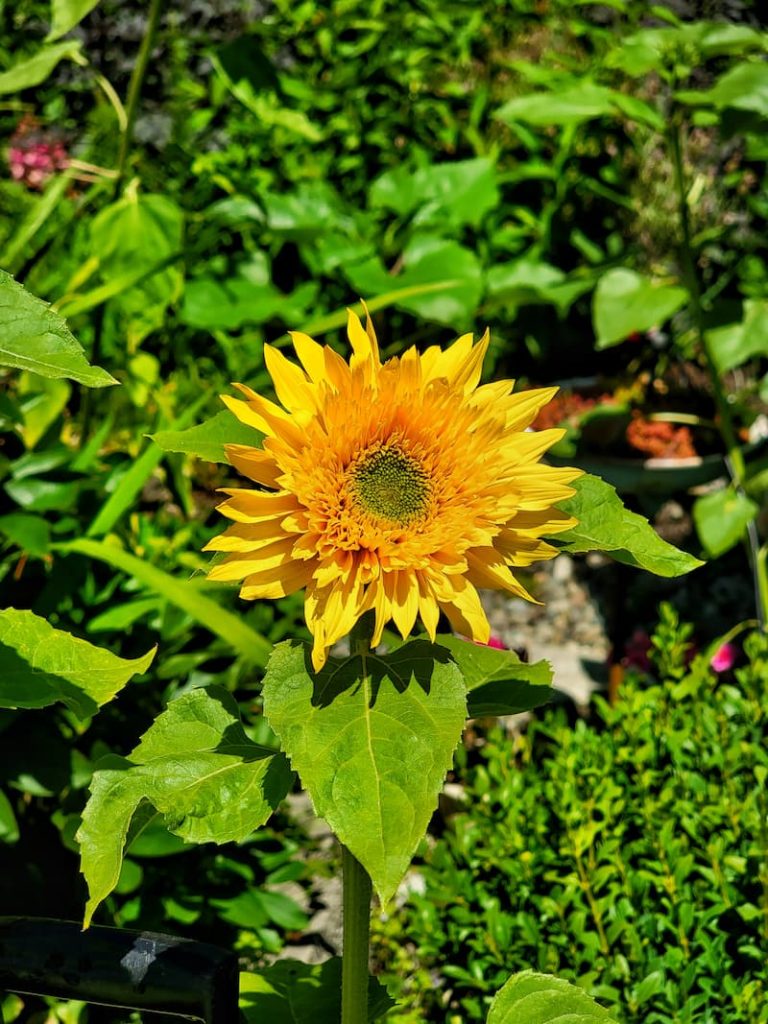
There’s nothing quite like harvesting sunflowers—it’s such a rewarding way to wrap up the season!
Whether you’re cutting fresh blooms to bring indoors, saving seeds for snacking or next year’s garden, or just leaving a few heads out for the birds to enjoy, knowing when and how to harvest makes all the difference.
For cut flowers, wait until the blooms are fully open but not yet dropping petals. Cut the stems early in the morning when they’re well-hydrated, and place them in water right away. Sunflowers look stunning in vases and can last over a week with a fresh water change every couple of days.
To harvest seeds, wait until the flower heads start to droop and the backs turn yellow or brown. The seeds should look full and feel firm to the touch. You can cut the head off with about a foot of stem, then hang it upside down in a dry, well-ventilated space. Cover the head with mesh or paper to catch any falling seeds and keep birds away.
Once the head is dry, rub the seeds out by hand or with a soft brush, and let them air-dry for a few more days before storing. You can snack on them, toss them into the bird feeder, or save them to plant next year.
Cutting Sunflowers for Display
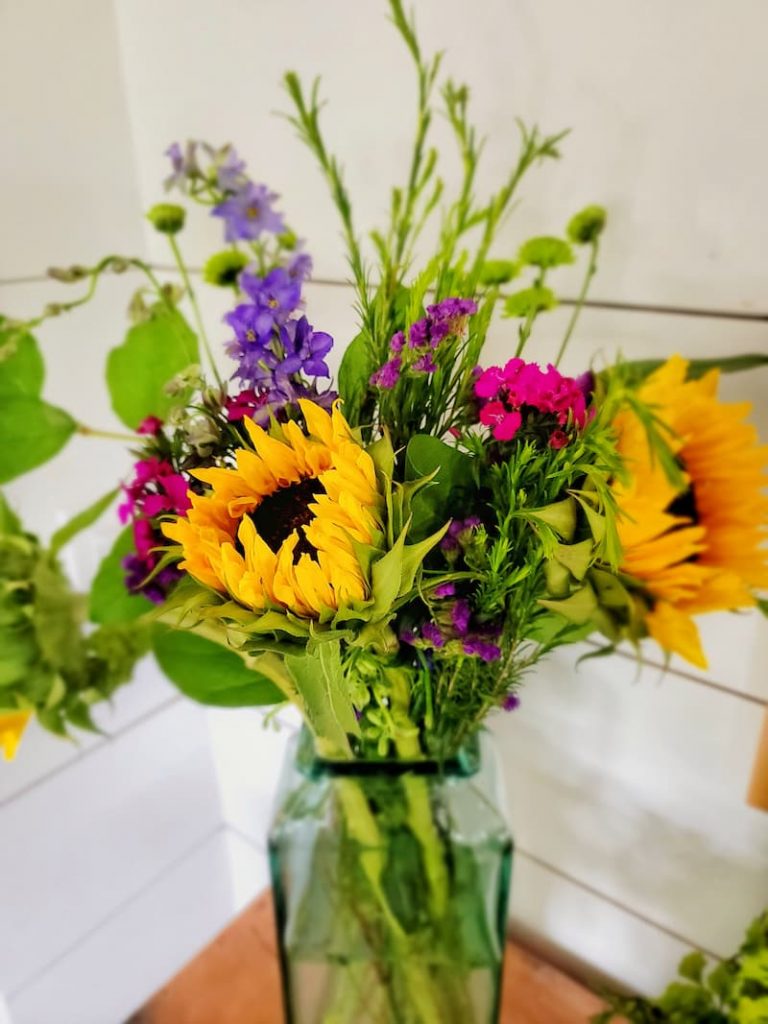
Sunflowers make beautiful cut flowers! Here are the steps to cutting flowers to take inside.
- To ensure long-lasting and vibrant blooms, it’s best to cut sunflowers early morning or late evening when temperatures are cooler and the plants are well-hydrated.
- Choose stems with flower buds that have just begun to open or are fully open but still have firm flowers.
- Using clean, sharp shears or a knife, cut the stem at a 45-degree angle, about 12-18 inches long, and immediately place the cut stems in a bucket of water.
- Remove any leaves below the waterline in your vase to prevent rot.
- To extend the sunflowers’ vase life, arrange them in fresh water with flower food and change the water every few days.
Harvesting Sunflower Seeds

Harvesting sunflower seeds is a great way to enjoy the results of your hard work—and it’s all about timing.
Let the sunflower heads stay on the plant until they’re fully ripe. You’ll know they’re ready when the back of the flower turns from green to yellow-brown, and the seeds look plump and feel loose in the head.
To keep birds and squirrels from getting to them first, cover the heads with mesh or cheesecloth while they finish drying on the plant. Once they’re fully dry, cut off the seed heads, leaving about 12 inches of stem to make them easier to handle.
To collect the seeds, rub them out with your fingers or a soft brush, or give the flower head a gentle tap on a hard surface. Remove any leftover plant bits, then spread the seeds out on a tray in a cool, dry spot to finish drying for a few days.
Once dry, store your seeds in an airtight container and keep them in a cool, dry place until you’re ready to use them.
You’ve got options!
- Roast them with a little oil and salt for a tasty snack,
- Leave them raw to fill your bird feeder, or
- Save them to plant again in next year’s garden.
Sunflower Growth Hacks – Do They Work?
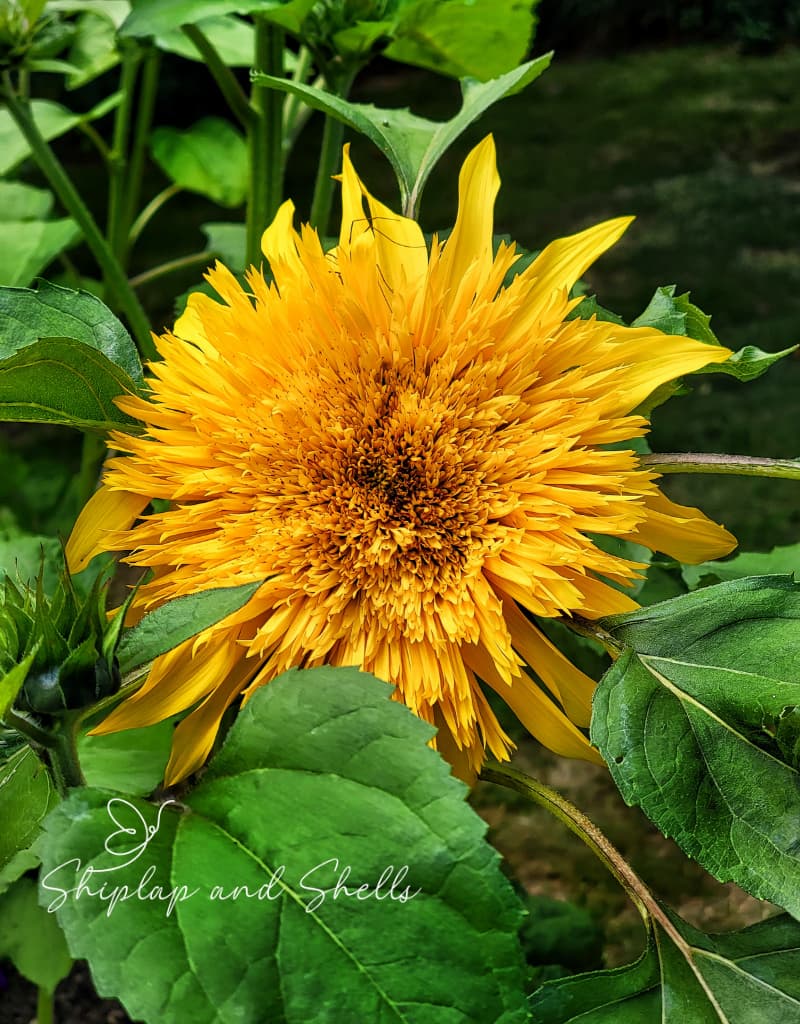
Gardeners love to swap tips and tricks for growing the tallest, brightest sunflowers—from quirky planting methods to DIY fertilizers and homemade pest solutions. But do these “hacks” really work, or are they just garden gossip?
Let’s take a look at one of the most talked-about sunflower growth tricks and whether it actually helps.
Do Coffee Grounds Help Sunflowers Grow Better?
Yes—coffee grounds can help, but only when used in moderation!
Coffee grounds are rich in nitrogen, which is great for supporting healthy leaf and stem growth. You can work them into your compost pile, or sprinkle a light layer around the base of your sunflowers to slowly release nutrients and improve the soil’s texture.
Just don’t go overboard—too many coffee grounds can make the soil too acidic or cause compaction, which can hurt your plants instead of helping them.
For the best results, mix coffee grounds with other organic matter like compost, mulch, or leaf mold. This helps create a more balanced, nutrient-rich environment where your sunflowers can really thrive.
Does Epsom Salt Help Sunflowers Grow?
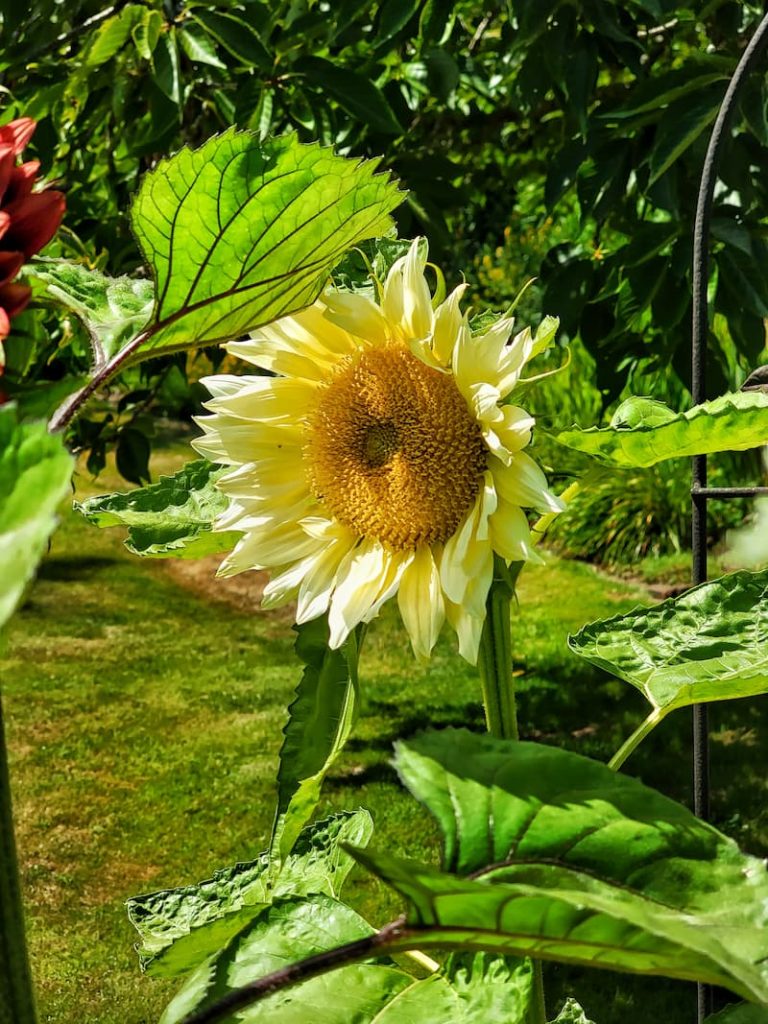
It can—in the right situation! Epsom salt is made up of magnesium sulfate, which can be helpful for sunflower growth if your soil is low in magnesium.
Magnesium is important for making chlorophyll (the stuff that makes leaves green), and it helps sunflowers absorb nutrients more efficiently. The sulfur in Epsom salt also supports enzyme activity and overall plant health.
If a soil test shows a magnesium deficiency, Epsom salt can give your plants a helpful boost. Here’s how to use it:
- Mix 1–2 tablespoons of Epsom salt into a gallon of water and use it to water your sunflowers every 2–4 weeks during the growing season.
- Or, sprinkle about a tablespoon of Epsom salt around the base of each plant and water it in well.
Just remember—not all sunflowers need it. Too much magnesium can throw off your soil’s nutrient balance, so it’s best to test your soil first to be sure it’s needed.
Final Thoughts on Growing and Caring for Sunflowers
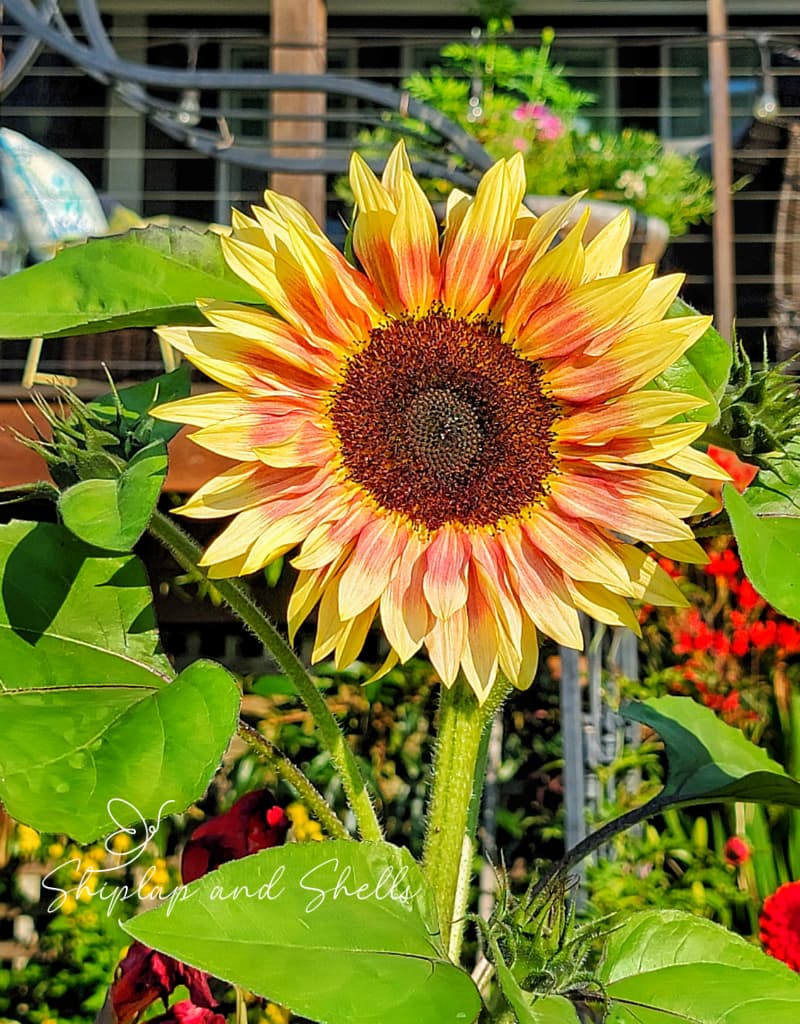
Sunflowers are a great addition to any garden with their sunny yellow petals. This annual plant attracts beneficial insects, such as bees and butterflies, and makes stunning cut flowers.
With their bright yellow faces and towering stems, sunflowers are a great addition to any garden. These sunny blooms not only look beautiful but also attract pollinators like bees and butterflies and make gorgeous cut flowers for your home.
From choosing the right variety and prepping the soil to watering, feeding, staking, and handling a few common challenges, each step along the way brings you closer to a garden full of cheerful blooms.
Even if pests or leggy growth pop up, a little care and attention go a long way. With the right know-how and a bit of patience, your sunflowers will flourish—whether you’re cutting them for a vase, snacking on roasted seeds, or simply enjoying them swaying in the summer breeze.
I hope this guide helps you feel confident and inspired to grow your own sunflower patch from seed! If you have questions or your own favorite sunflower tips, I’d love to hear them in the comments.
If this post was helpful, feel free to share it with a fellow gardener who might enjoy growing sunflowers.
May your garden be full of sunshine!
Until next time,
Happy Gardening!

I’m a self-taught hobby gardener. Everything I share on my blog is my opinion and what has worked for me.
MORE POSTS
For You To Enjoy
Follow Me for More Inspiration
Shop my Amazon Storefront, LTK sources, and favorite home decor, garden, and lifestyle products. When you purchase from one of my links, I earn a small commission, which helps me continue sharing all the content you expect on my blog.
Be sure to follow me on Pinterest, Instagram, Facebook, TikTok and LIKEtoKNOW.it. Do you like gardening? Join my Facebook Gardening Tips & Tricks group.




